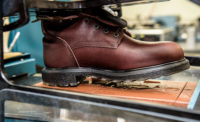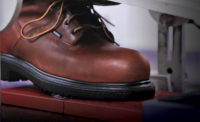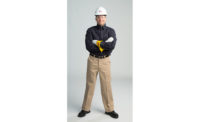The importance of safety can’t be underestimated. Providing personal protective equipment (PPE) is essential in industries that require employees to work in harsh and hazardous conditions, from manufacturing to transportation, construction and more.
Each industry faces potential hazards that can harm employees and workers. These include sharp objects, such as nails or knives that can pierce the sole of a shoe; falling or rolling objects, such as heavy boxes in a warehouse; or electric shock from exposed wires.
Companies need to provide PPE that not only helps prevent injuries but also complies with the latest safety standards. Here are safety standards from three organizations for footwear and garments.
ASTM Safety Footwear Standards
ASTM International (formerly the American Society of Testing and Materials) introduced three updated standards to guide test laboratories and companies that use protective footwear with improved testing and performance data. The most widely recognized safety footwear standard in the U.S. today is ASTM F2413. The first version of the ASTM safety standard was published in 2005, revised in 2011, and recently revised again in 2018 as ASTM F2413-18. With each new revision to the standard, shoe manufacturers/providers are required to recertify existing styles within one year of the publishing date.
The standards specify performance requirements for protective toe-cap footwear, standard test methods for foot protection, and performance requirements for soft-toe protective footwear. The ASTM F2413-18 standard contains basic requirements to assess footwear, including:
- Impact (I) resistance for the toe area
- Compression (C) resistance for the toe area
- Metatarsal (Mt) protection for the metatarsal bones at the top of the foot
- Conductive (Cd) properties to reduce static electricity buildup and lower the possibility of ignition of explosives, volatile chemicals or fine particulates in the air
- Electric hazard (EH) protection when accidentally stepping on live electric wires
- Static dissipative (SD 10, 35 or 100) properties, allowing for three levels of protection, to reduce hazards that result from a buildup of static charge where there is risk of accidental contact with live electrical circuits
- Puncture resistance (PR) to protect the bottom of the foot from sharp penetrating objects
Requirements for Soft-Toe Protective Footwear are found in ASTM F2892-18 Standard Specification for Performance Requirements for Soft-Toe Protective Footwear (Non-Safety / Non-Protective Toe). Protections covered by ASTM F2892-18 include conductive properties, electric hazard protection, static dissipative properties and puncture resistance.
For purchasers of protective footwear, identification of the specific protections that the footwear provides is essential to ensure the required minimum performance criteria are met. This can be achieved by reviewing the required label permanently attached to the footwear.
- Line 1 of label: ASTM F2413-18 (ASTM Standard No. – Year of Issuance)
- Line 2 of label: M/I/C (appropriate gender, M or F, and the Impact and Compression resistance)
- Line 3 of label: Mt/EH/PR (additional protections)
In addition, a Certificate of Conformance (COC) issued by a third-party laboratory should be available to verify the footwear meets these protections.
NFPA standards
The National Fire Protection Association (NFPA) is a global nonprofit organization devoted to saving lives and reducing injury, property and economic damage. The NFPA delivers knowledge through more than 300 consensus codes and standards, education, research and training designated to minimize the risk and effects of fire hazards.1 Two NFPA standards relating to flame-resistant protective garments are 70E and 2112.
NFPA 70E
NFPA 70E is the standard for electrical safety in the workplace. The scope of this standard is to offer guidance relative to hazards stemming from the use of electricity.
NFPA 70E states that the main priority should be the elimination of any hazard. In fact, hundreds of deaths and thousands of burn injuries could be prevented through compliance with NFPA 70E. NFPA 70E addresses information about the effects of arc flash, arc blast and direct current (DC) hazards. Risk-specific 70E lists the standards that arc-rated clothing and other personal protective equipment should comply with. However, PPE garments cannot be labeled as compliant or certified to NFPA 70E.2
NFPA 2112
NFPA 2112 is the standard on flame-resistant clothing for protection of industrial personnel against short-duration thermal exposures from fire. The standard applies to the design, manufacture and certification of flame-resistant garments for the protection of workers from flash-fire exposure and injury by specifying requirements for flame-resistant fabric and garments to reduce the severity of flash fire burn injuries.3 NFPA 2112 is not applicable to wildland or structural firefighting.
EU footwear standards
Similar to ASTM, EU PPE footwear standards are separated into Safety (EN ISO 20345) with Safety Toecap, and Occupational Non-Safety Toe (EN ISO 20347). They are also categorized between footwear made from leather and other materials (Class 1) versus all-rubber or polymeric (Class 2).
The EU standards go beyond safety elements and also incorporate performance requirements for the footwear and its components. Design, durability and comfort specifications are mandated by the standards.
If workers are wearing PPE that doesn’t meet the latest safety standards, it could put them at risk for jobsite injuries. It’s the responsibility of the safety manager to be aware of and understand the latest safety standards in order to select the right PPE solutions for the work environment, ensuring their employees are outfitted in products that will help keep them safe day after day.
- National Fire Protection Administration, NFPA Overview: https://www.nfpa.org/overview
- National Fire Protection Administration, List of NFPA codes and standards, NFPA 2112: https://www.nfpa.org/codes-and-standards/all-codes-and-standards/list-of-codes-and-standards/detail?code=2112
- National Fire Protection Administration, NFPA Catalog, NFPA 70E: https://catalog.nfpa.org/NFPA-70E-Standard-for-Electrical-Safety-in-the-Workplace-P1197.aspx






